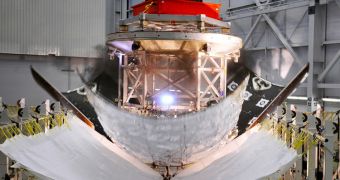Officials at NASA announce that a second fairing separation test conducted on the Orion Multipurpose Crew Vehicle (MPCV) was completed successfully on Wednesday, November 6. This success brings the spacecraft one step closer to its maiden flight, scheduled for next year.
The test took place at Lockheed Martin's Sunnyvale, California location. During the assessment, NASA experts looked at how three massive panels encasing Orion's service modules were jettisoned from their initial positions. This is what will happen when the vehicle launches for real.
Each of the panels measures 4.2 by 3.9 meters (14 by 13 feet) and is responsible for protecting one side of the Orion service module. These fairings will prevent mechanical vibrations, excessive winds, scorching heat, and deep acoustics from damaging the spacecraft as it roars into space.
NASA experts say that the service module is a critically-important component of the Orion spacecraft, as it is located right under the capsule housing the crew. It contains all propulsion systems that will be used when the vehicle is in space, including for altitude control and orbital transfers.
In addition, this module includes water and air reserves, thermal control systems, and equipment for generating and storing electricity. When the first manned Orion MPCV launches, in 2021, the service module will be what ensures the survival of the astronauts on board.
At this point, the first real-life test for the MPCV and its service module is Exploration Flight Test-1 (EFT-1), which is scheduled to occur in September 2014. At that time, the spacecraft will be launched to an altitude of 5,800 kilometers (3,600 miles), and then return to Earth relying on systems that will be used during manned space exploration.
“Hardware separation events like this are absolutely critical to the mission and some of the more complicated things we do,” explains JSC Orion Program Manager Mark Geyer. The Johnson Space Center coordinates the development of the spacecraft for NASA.
“We want to know we've got the design exactly right and that it can be counted on in space before we ever launch,” the official says. During an actual mission, the service module fairings will have to be ejected at an altitude of 171,000 meters (560,000 feet).
Orion MPCV will be launched aboard Delta IV rockets for its test flights. Real-life missions will use the NASA Space Launch System, currently scheduled for a first test flight around 2018.

 14 DAY TRIAL //
14 DAY TRIAL //